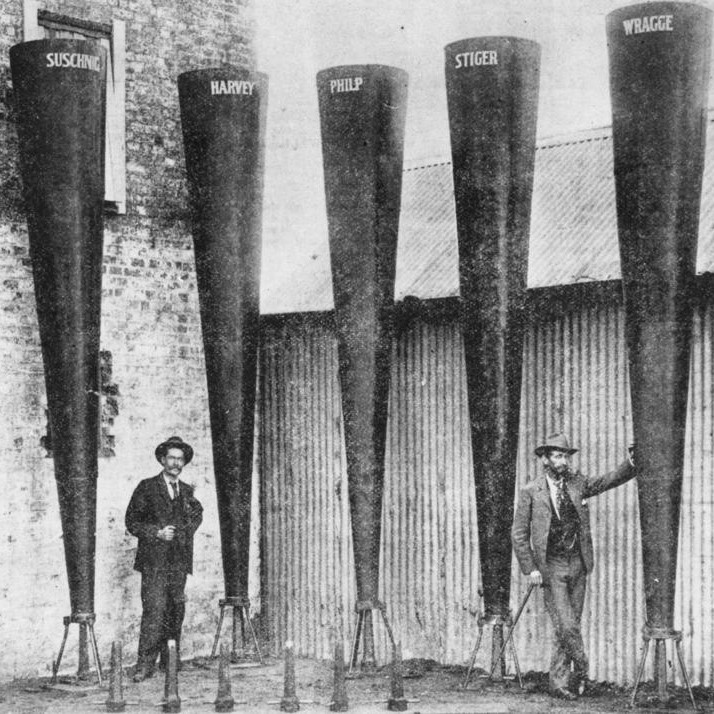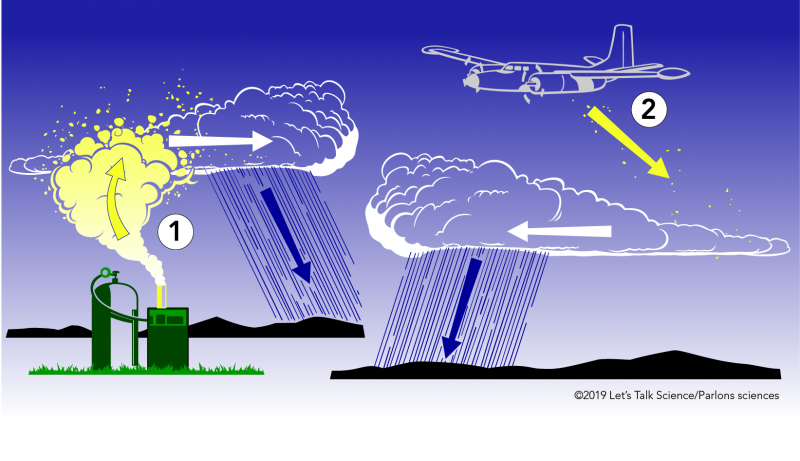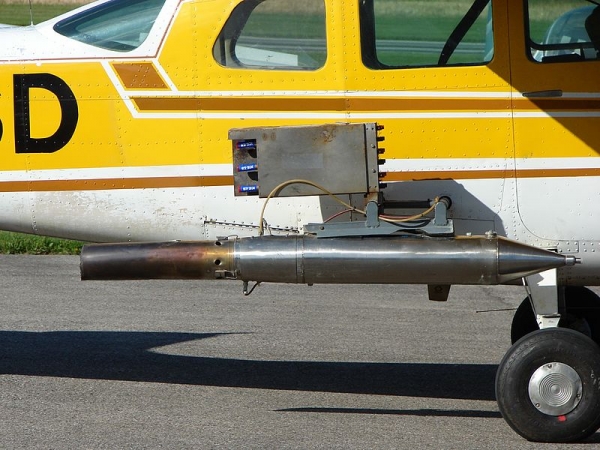What is Cloud Seeding?

Battery of Stiger Vortex rainmaking guns at Charleville, Australia, in 1902 (The Queenslander [public domain], Wikimedia Commons)

Battery of Stiger Vortex rainmaking guns at Charleville, Australia, in 1902 (The Queenslander [public domain], Wikimedia Commons)
How does this align with my curriculum?
| Grade | Course | Topic |
|---|
Cloud seeding is a type of weather modification. Learn about cloud seeding, as well as its risks and benefits.
When you got up this morning, you probably wondered what the weather would be like. Any rain in the forecast? Fog? Maybe snow? Any storm warnings? People have always tried to predict the weather so they can prepare for it. After all, we have no control over the weather. Or do we?
Cloud physicists study weather modification. They have found ways to tweak the weather. Let’s look at a weather modification technology called cloud seeding.
What Is a Cloud?
Clouds are made up of tiny water droplets called cloud droplets. Groups of cloud droplets form water vapour (gas) or ice crystals.
Water vapour isn’t dense enough to fall to the ground as precipitation. Instead, it rises into the sky and becomes supercooled. Eventually, it condenses (turns to a liquid) around tiny particles of dust in the sky. These tiny particles are called condensation nuclei. It takes billions of these condensed water droplets to form a visible cloud.
What Is Cloud Seeding?
Clouds carry water. Unfortunately, that water doesn’t always get to where it’s needed on the ground.
When the water molecules are spread out, they aren’t dense enough to feel Earth’s gravity. When the molecules huddle together, they form larger, heavier droplets. Eventually, they become heavy enough to fall to the ground as precipitation.
Cloud seeding involves modifying a cloud’s structure to increase the chance of precipitation. Cloud seeding adds small, ice-like particles to clouds. Usually, silver iodide particles are used.
These particles act as additional condensation nuclei. Unattached supercooled water vapour molecules in the clouds condense around these particles. Then, the condensed water vapour droplets group together. This process continues until the droplets are large enough to fall as rain!
There are two ways of adding particles to clouds:
- Using large cannons that shoot particles into the sky
- Using airplanes that drop the particles from above

Why Use Cloud Seeding?
There are a lot of reasons to use cloud seeding. Ski resorts use it to increase snowfall. Hydroelectric companies do too, because more snow means more runoff in the spring. And more runoff means more water for electricity.
Cloud seeding can also clear away fog by turning it into precipitation. This can help improve visibility around airports.
In Alberta, cloud seeding is used to manage hail. It increases the number of ice pellets in hail-producing clouds. But it also decreases the size of each pellet. This reduces the damage caused by hail.
Did you know?
Cloud seeding was first used in Canada in 1956. Back then, the goal was to protect crops in Alberta from hail damage.

Are you wondering whether cloud seeding can be used to fight drought? Or forest fires, like the one that devastated Fort McMurray in 2016? Not necessarily. Cloud seeding can’t create clouds. It can only add particles to clouds. These particles interact with the water vapour already present in the air.
But China, Russia, and Thailand have successfully put out forest fires with cloud seeding. Scientists in Australia have also suggested using cloud seeding to get more water from clouds when it does rain, then saving that water for times of drought.
What Are the Potential Dangers of Cloud Seeding?
Cloud seeding has many uses. It’s been around for a long time. But not everyone is convinced it’s a good idea. Why?
There is evidence that cloud seeding works. It can create a 10-15% increase in rainfall. But some argue that this benefit doesn’t outweigh the risks to public safety and the environment.
Silver iodide, the material used in cloud seeding, is toxic to aquatic life. So precipitation from seeded clouds can harm the environment.
In response to these concerns, scientists have tested nontoxic replacements for silver iodide. They have found calcium chloride to be effective. Low doses of this salt are unlikely to harm the environment. Cloud physicists are also researching the possibility of using negatively charged ions instead of ice-like crystals.
Did you know?
At the 2008 Olympics in Beijing, cloud seeding was used to ward off rain during the opening ceremonies.
But there are other potential risks to increasing precipitation in a specific area. Will rain in one area bring drought to another? Could cloud seeding cause too much rain to fall? Can it cause flooding? Scientists don’t know all the answers. After all, weather systems are very complex. It’s impossible to predict exactly how weather modification efforts will play out.
So far, no droughts have been blamed on cloud seeding. In fact, surrounding areas tend to get more rather than less rain. In 1972, a flash flood devastated Rapid City, South Dakota. People there suspected that nearby cloud seeding operations might have been a factor. There is no proof that cloud seeding was to blame. Still, events like this one are bound to make people skeptical.
Weather modification techniques have also been used as weapons. For example, during the Vietnam War, the United States ran Operation Popeye. It used weather modification technology to extend the monsoon season in Vietnam. This flooded the roads and rivers that enemy troops normally used. In 1977, an international treaty banned the use of weather modification for military and other hostile purposes.

Did you know?
Cloud seeding is just one of many technologies used to control the weather. Together, these technologies form the field of geoengineering. It focuses on fighting climate change.
Summing Up...
Some governments are staunch supporters of weather modification technology. China and Russia are two of these countries. But in North America, cloud seeding doesn’t receive government funding. It’s still too controversial. That hasn’t kept private companies from using it, though. For example, we talked about how cloud seeding is used to reduce hail in Alberta. A lot of these projects are funded by insurance companies. That’s because hail in Alberta tends to damage a lot of property, and the insurance companies have to pay up for it!
Like all technologies, weather modification has potential advantages and dangers. People need to carefully weigh these pros and cons.
Starting Points
- Most people just assume that we have no control over the weather. Did you already know that weather modification technology existed? If so, where did you learn about it?
- Have there been situations in your life where cloud seeding could have been helpful? Explain.
- What concerns would you have if you found out cloud seeding was going to be used near where you live?
- Should private companies be allowed to use cloud seeding, or should governments alone be allowed to use it? Explain.
- Why do you think countries signed a treaty banning the use of weather modification as a weapon of war?
- It was reported that China spent $100 million a year on rain making efforts in preparation for the 2008 Summer Olympic Games. Do you think it was worth it? Explain.
- In the future, do you think it will be possible to order up sunshine, snow or rain whenever and wherever we want? Do you think that would be a good thing?
- Explain how cloud seeding works. How does cloud seeding affect precipitation?
- What methods are used to deploy cloud seeds? Which method has the greatest success?
- For what purposes has cloud seeding been used? In which situations has it been banned?
- What is geoengineering? Conduct additional research to find out more.
- Concept Definition: Should cloud seeding be banned until scientists can precisely determine its impacts on the environment? Explain.
- It’s difficult for meteorologists to accurately and precisely describe a phenomenon like rainfall. Does this make meteorology less of a science than physics or chemistry? Explain.
- This article can be used to support teaching and learning of Earth Science, Weather and Technology & Engineering related to clouds, crystals and precipitation. Concepts introduced include cloud physicists, cloud seeding, precipitation, supercooled, condenses and condensation nuclei.
- After reading this article, teachers could have students complete a Concept Definition Web learning strategy to help consolidate understanding of the concept of cloud seeding. Ready-tuse Concept Definition Web reproducibles are available in [Google doc] and [.pdf] formats.
- After reading this article, teachers could have students consider the risks and benefits of using cloud seeding technology using a Cost-Benefit Analysis learning strategy. Download a ready-to-use Cost-Benefit Analysis reproducibles for this article in [Google doc] and [.pdf] formats.
- To go further, teachers could have students explore the issue of using cloud seeding for a specific purpose (e.g., farmers trying to reduce hail damage to crops, insurance company trying to reduce hail damage, an Olympic host trying to ensure prefect opening ceremony or competition environment, etc.) from different stakeholder perspectives, using an Issues & Stakeholders Learning strategy. Ready-to-use Issues & Stakeholders reproducibles are available in [Google doc] and [.pdf] formats.
Connecting and Relating
- Most people just assume that we have no control over the weather. Did you already know that weather modification technology existed? If so, where did you learn about it?
- Have there been situations in your life where cloud seeding could have been helpful? Explain.
- What concerns would you have if you found out cloud seeding was going to be used near where you live?
Relating Science and Technology to Society and the Environment
- Should private companies be allowed to use cloud seeding, or should governments alone be allowed to use it? Explain.
- Why do you think countries signed a treaty banning the use of weather modification as a weapon of war?
- It was reported that China spent $100 million a year on rain making efforts in preparation for the 2008 Summer Olympic Games. Do you think it was worth it? Explain.
- In the future, do you think it will be possible to order up sunshine, snow or rain whenever and wherever we want? Do you think that would be a good thing?
Exploring Concepts
- Explain how cloud seeding works. How does cloud seeding affect precipitation?
- What methods are used to deploy cloud seeds? Which method has the greatest success?
- For what purposes has cloud seeding been used? In which situations has it been banned?
- What is geoengineering? Conduct additional research to find out more.
Nature of Science/Nature of Technology
- Concept Definition: Should cloud seeding be banned until scientists can precisely determine its impacts on the environment? Explain.
- It’s difficult for meteorologists to accurately and precisely describe a phenomenon like rainfall. Does this make meteorology less of a science than physics or chemistry? Explain.
Teaching Suggestions
- This article can be used to support teaching and learning of Earth Science, Weather and Technology & Engineering related to clouds, crystals and precipitation. Concepts introduced include cloud physicists, cloud seeding, precipitation, supercooled, condenses and condensation nuclei.
- After reading this article, teachers could have students complete a Concept Definition Web learning strategy to help consolidate understanding of the concept of cloud seeding. Ready-tuse Concept Definition Web reproducibles are available in [Google doc] and [.pdf] formats.
- After reading this article, teachers could have students consider the risks and benefits of using cloud seeding technology using a Cost-Benefit Analysis learning strategy. Download a ready-to-use Cost-Benefit Analysis reproducibles for this article in [Google doc] and [.pdf] formats.
- To go further, teachers could have students explore the issue of using cloud seeding for a specific purpose (e.g., farmers trying to reduce hail damage to crops, insurance company trying to reduce hail damage, an Olympic host trying to ensure prefect opening ceremony or competition environment, etc.) from different stakeholder perspectives, using an Issues & Stakeholders Learning strategy. Ready-to-use Issues & Stakeholders reproducibles are available in [Google doc] and [.pdf] formats.
Learn more
How to (Try to) Make It Rain (2014)
Article on Scientific American by Dan Baum listing five ways, including cloud seeding, that humans have attempted to control the weather.
Has the Time Come to Try Geoengineering? (2012)
Scientific American blog entry by David Biello arguing for weather modification technology to be given more consideration in the fight against global warming.
China's 'Sky River' Will Be The Biggest Artificial Rain Experiment Ever (2018)
Article on Science Alert by Perter Dockrill discussing China’s proposal to create clouds. This could change weather modification technology as we know it.
References
CBC News. (2014, August 22). Alberta's cloud-seeding pilots see 2nd busiest year in 20 years.
Chen, A. (2018, January 22). Does cloud seeding really work? An experiment above Idaho suggests humans can turbocharge snowfall. Science.
Coonan, C. (2008, August 11). How Beijing used rockets to keep opening ceremony dry. Independent.
French, J., & Tessendorf, S. (2018, March 14). Does cloud seeding work? Scientists watch ice crystals grow inside clouds to find out. The Conversation.
Farhar, B. C. (1974). The impact of the Rapid City flood on public opinion about weather modification. American Meteorological Society, 55(7), 759-764.
Tucker, E. (2018, October 11). Fact file: Cloud seeding. Global News.
UCAR Center for Science Education. (2019). Clouds and how they form.
Vanderklippe, N. (2016, May 10). Making it rain. The Globe and Mail.